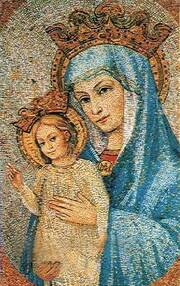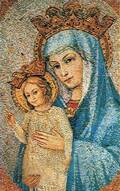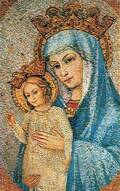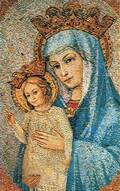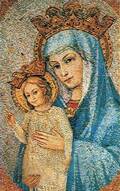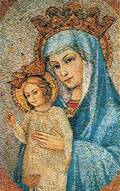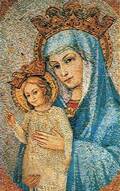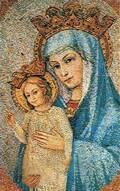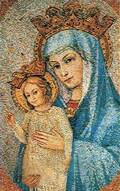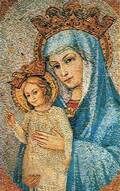Novena to Our Lady
with quotes from Saint John Paul II's encyclical, Redemptoris Mater, 'on the Blessed Virgin Mary in the life of the Pilgrim Church', which JPII gave to us on the Solemnity of the Annunciation 1987. The daily prayer is a Consecration to Jesus through the Immaculate Heart of Mary:
Most lovable and adorable Jesus, who suffered your Passion to save us,
I adore your ever glorified Heart; you who willed, though being God,
to submit in all things to Mary, your Holy Mother.
In spite of my littleness and my poor love,
I desire to respond to the immense love of your Sacred Heart.
So as to unite myself ever more closely with you,
I turn to this incomparable Mother, whom you have given to me.
I consecrate myself to the Immaculate Heart of Mary so as better to belong to you.
I greet you O Mary, Immaculate Virgin, Queen of heaven and earth,
sure refuge of the sinner I am.
Hail Mary, Beloved Daughter of the Father,
Mother of the Son, faithful Spouse of the Holy Spirit.
Secure in your hands, I renew my baptismal promises and through you
I give myself entirely to Jesus Christ, my King, my Saviour and my God.
I choose you today with joy as my Mother and my Queen,
and I entrust to you my life and my soul.
I want to love you and to make you loved, to serve you
and to receive from you every grace, so that you can make me worthy of Jesus.
Incomparable Mother, to this end give me the grace to be amongst those whom you teach, lead and protect.
To be worthy of these privileges, I promise to go to confession regularly, to receive Jesus in the Eucharist, to observe the commandments of God, to pray every day and to recite the rosary; to be a source of unity through a great love for the Pope, the bishops and the priests, and through fidelity to the faith. Help me to flee from sin, protect me from selfishness, lies, impurities and all harm. Make me so perfect an imitator of Christ that I can, through your intercession and your example, come to resemble Him in all things.
And since I belong to you, O my Mother, keep me and defend me now and at the hour of my death. Amen.
The Ave Marias are sung by the London Oratory School Schola.
You can pray this novena at any time; it was recorded especially to begin on 30th August, in preparation for Our Lady's birthday (8th September ... & in 2010 Totus2us' 1st birthday!). It was offered up especially for the future of Totus2us and for all those who've contributed so generously to Totus2us, either with their words, prayers, music and art on the podcasts, or by their prayers, help or financial support. And THANK YOU Angelika, Celia, Frankie, Sr Hyacinthe & Rebecca :o)
You can read Redemptoris Mater in English, French, German, Hungarian, Italian, Latin, Polish, Portuguese & Spanish. You can subscribe to this Totus2us podcast here on the RSS feed or here on itunes. To download the free mp3 audio recordings individually, right/double click on the play buttons.
Day 1 of Totus2us's Novena to Our Lady 
When we read that the messenger addresses Mary as "full of grace", the Gospel context, which mingles revelations and ancient promises, enables us to understand that among all the "spiritual blessings in Christ" this is a special "blessing." In the mystery of Christ she is present even "before the creation of the world," as the one whom the Father "has chosen" as Mother of his Son in the Incarnation. And, what is more, together with the Father, the Son has chosen her, entrusting her eternally to the Spirit of holiness. In an entirely special and exceptional way Mary is united to Christ, and similarly she is eternally loved in this "beloved Son," this Son who is of one being with the Father, in whom is concentrated all the "glory of grace." At the same time, she is and remains perfectly open to this "gift from above". As the Council teaches, Mary "stands out among the poor and humble of the Lord, who confidently await and receive salvation from him."
9. If the greeting and the name "full of grace" say all this, in the context of the angel's announcement they refer first of all to the election of Mary as Mother of the Son of God. But at the same time the "fullness of grace" indicates all the supernatural munificence from which Mary benefits by being chosen and destined to be the Mother of Christ. If this election is fundamental for the accomplishment of God's salvific designs for humanity, and if the eternal choice in Christ and the vocation to the dignity of adopted children is the destiny of everyone, then the election of Mary is wholly exceptional and unique. Hence also the singularity and uniqueness of her place in the mystery of Christ.
The divine messenger says to her: "Do not be afraid, Mary, for you have found favor with God. And behold, you will conceive in your womb and bear a son, and you shall call his name Jesus. He will be great, and will be called the Son of the Most High" (Lk. 1:30-32). And when the Virgin, disturbed by that extraordinary greeting, asks: "How shall this be, since I have no husband?" she receives from the angel the confirmation and explanation of the preceding words. Gabriel says to her: "The Holy Spirit will come upon you, and the power of the Most High will overshadow you; therefore the child to be born will be called holy, the Son of God" (Lk. 1:35).
The Annunciation, therefore, is the revelation of the mystery of the Incarnation at the very beginning of its fulfillment on earth. God's salvific giving of himself and his life, in some way to all creation but directly to man, reaches one of its high points in the mystery of the Incarnation. This is indeed a high point among all the gifts of grace conferred in the history of man and of the universe: Mary is "full of grace," because it is precisely in her that the Incarnation of the Word, the hypostatic union of the Son of God with human nature, is accomplished and fulfilled. As the Council says, Mary is "the Mother of the Son of God. As a result she is also the favorite daughter of the Father and the temple of the Holy Spirit. Because of this gift of sublime grace, she far surpasses all other creatures, both in heaven and on earth."
10. The Letter to the Ephesians, speaking of the "glory of grace" that "God, the Father .. has bestowed on us in his beloved Son," adds: "In him we have redemption through his blood" (Eph 1:7). According to the belief formulated in solemn documents of the Church, this "glory of grace" is manifested in the Mother of God through the fact that she has been "redeemed in a more sublime manner." By virtue of the richness of the grace of the beloved Son, by reason of the redemptive merits of him who willed to become her Son, Mary was preserved from the inheritance of original sin. In this way, from the first moment of her conception - which is to say of her existence - she belonged to Christ, sharing in the salvific and sanctifying grace and in that love which has its beginning in the "Beloved," the Son of the Eternal Father, who through the Incarnation became her own Son. Consequently, through the power of the Holy Spirit, in the order of grace, which is a participation in the divine nature, Mary receives life from him to whom she herself, in the order of earthly generation, gave life as a mother. The liturgy does not hesitate to call her "mother of her Creator" and to hail her with the words which Dante Alighieri places on the lips of St Bernard: "daughter of your Son." And since Mary receives this "new life" with a fullness corresponding to the Son's love for the Mother, and thus corresponding to the dignity of the divine motherhood, the angel at the Annunciation calls her "full of grace."
11. In the salvific design of the Most Holy Trinity, the mystery of the Incarnation constitutes the superabundant fulfillment of the promise made by God to man after original sin, after that first sin whose effects oppress the whole earthly history of man. And so, there comes into the world a Son, "the seed of the woman" who will crush the evil of sin in its very origins: "he will crush the head of the serpent." As we see from the words of the Protogospel, the victory of the woman's Son will not take place without a hard struggle, a struggle that is to extend through the whole of human history. The "enmity," foretold at the beginning, is confirmed in the Apocalypse (the book of the final events of the Church and the world), in which there recurs the sign of the "woman," this time "clothed with the sun" (Rev. 12:1).
Mary, Mother of the Incarnate Word, is placed at the very center of that enmity, that struggle which accompanies the history of humanity on earth and the history of salvation itself. In this central place, she who belongs to the "weak and poor of the Lord" bears in herself, like no other member of the human race, that "glory of grace" which the Father "has bestowed on us in his beloved Son," and this grace determines the extraordinary greatness and beauty of her whole being. Mary thus remains before God, and also before the whole of humanity, as the unchangeable and inviolable sign of God's election, spoken of in Paul's letter: "in Christ...he chose us...before the foundation of the world,...he destined us...to be his sons" (Eph. 1:4, 5). This election is more powerful than any experience of evil and sin, than all that "enmity" which marks the history of man. In this history Mary remains a sign of sure hope.
Day 2 of Totus2us's Novena to Our Lady 
23. If John's description of the event at Cana presents Mary's caring motherhood at the beginning of Christ's messianic activity, another passage from the same Gospel confirms this motherhood in the salvific economy of grace at its crowning moment, namely when Christ's sacrifice on the Cross, his Paschal Mystery, is accomplished. John's description is concise: "Standing by the cross of Jesus were his mother, and his mother's sister, Mary the wife of Clopas, and Mary Magdalene. When Jesus saw his mother, and the disciple whom he loved standing near, he said to his mother: 'Woman, behold your son!' Then he said to the disciple, 'Behold, your mother!' And from that hour the disciple took her to his own home" (Jn. 19:25-27).
Undoubtedly, we find here an expression of the Son's particular solicitude for his Mother, whom he is leaving in such great sorrow. And yet the "testament of Christ's Cross" says more. Jesus highlights a new relationship between Mother and Son, the whole truth and reality of which he solemnly confirms. One can say that if Mary's motherhood of the human race had already been outlined, now it is clearly stated and established. It emerges from the definitive accomplishment of the Redeemer's Paschal Mystery. The Mother of Christ, who stands at the very center of this mystery - a mystery which embraces each individual and all humanity - is given as mother to every single individual and all mankind. The man at the foot of the Cross is John, "the disciple whom he loved." But it is not he alone. Following tradition, the Council does not hesitate to call Mary "the Mother of Christ and mother of mankind": since she "belongs to the offspring of Adam she is one with all human beings.... Indeed she is 'clearly the mother of the members of Christ .. since she cooperated out of love so that there might be born in the Church the faithful.'"
And so this "new motherhood of Mary," generated by faith, is the fruit of the "new" love which came to definitive maturity in her at the foot of the Cross, through her sharing in the redemptive love of her Son.
24. Thus we find ourselves at the very center of the fulfillment of the promise contained in the Proto-gospel: the "seed of the woman .. will crush the head of the serpent". By his redemptive death Jesus Christ conquers the evil of sin and death at its very roots. It is significant that, as he speaks to his mother from the Cross, he calls her "woman" and says to her: "Woman, behold your son!" Moreover, he had addressed her by the same term at Cana too. How can one doubt that especially now, on Golgotha, this expression goes to the very heart of the mystery of Mary, and indicates the unique place which she occupies in the whole economy of salvation? As the Council teaches, in Mary "the exalted Daughter of Sion, and after a long expectation of the promise, the times were at length fulfilled and the new dispensation established. All this occurred when the Son of God took a human nature from her, that he might in the mysteries of his flesh free man from sin."
The words uttered by Jesus from the Cross signify that the motherhood of her who bore Christ finds a "new" continuation in the Church and through the Church, symbolized and represented by John. In this way, she who as the one "full of grace" was brought into the mystery of Christ in order to be his Mother and thus the Holy Mother of God, through the Church remains in that mystery as "the woman" spoken of by the Book of Genesis (3:15) at the beginning and by the Apocalypse (12:1) at the end of the history of salvation. In accordance with the eternal plan of Providence, Mary's divine motherhood is to be poured out upon the Church, as indicated by statements of Tradition, according to which Mary's "motherhood" of the Church is the reflection and extension of her motherhood of the Son of God.
According to the Council the very moment of the Church's birth and full manifestation to the world enables us to glimpse this continuity of Mary's motherhood: "Since it pleased God not to manifest solemnly the mystery of the salvation of the human race until he poured forth the Spirit promised by Christ, we see the Apostles before the day of Pentecost 'continuing with one mind in prayer with the women and Mary the mother of Jesus, and with his brethren' (Acts 1:14). We see Mary prayerfully imploring the gift of the Spirit, who had already overshadowed her in the Annunciation."
And so, in the redemptive economy of grace, brought about through the action of the Holy Spirit, there is a unique correspondence between the moment of the Incarnation of the Word and the moment of the birth of the Church. The person who links these two moments is Mary: Mary at Nazareth and Mary in the Upper Room at Jerusalem. In both cases her discreet yet essential presence indicates the path of "birth from the Holy Spirit." Thus she who is present in the mystery of Christ as Mother becomes - by the will of the Son and the power of the Holy Spirit - present in the mystery of the Church. In the Church too she continues to be a maternal presence, as is shown by the words spoken from the Cross: "Woman, behold your son!"; "Behold, your mother.
Day 3 of Totus2us's Novena to Our Lady 
Now, at the Visitation, when Elizabeth's greeting bears witness to that culminating moment, Mary's faith acquires a new consciousness and a new expression. That which remained hidden in the depths of the "obedience of faith" at the Annunciation can now be said to spring forth like a clear and life - giving flame of the spirit. The words used by Mary on the threshold of Elizabeth's house are an inspired profession of her faith, in which her response to the revealed word is expressed with the religious and poetical exultation of her whole being towards God. In these sublime words, which are simultaneously very simple and wholly inspired by the sacred texts of the people of Israel, Mary's personal experience, the ecstasy of her heart, shines forth. In them shines a ray of the mystery of God, the glory of his ineffable holiness, the eternal love which, as an irrevocable gift, enters into human history.
Mary is the first to share in this new revelation of God and, within the same, in this new "self-giving" of God. Therefore she proclaims: "For he who is mighty has done great things for me, and holy is his name." Her words reflect a joy of spirit which is difficult to express: "My spirit rejoices in God my Savior." Indeed, "the deepest truth about God and the salvation of man is made clear to us in Christ, who is at the same time the mediator and the fullness of all revelation." In her exultation Mary confesses that she finds herself in the very heart of this fullness of Christ. She is conscious that the promise made to the fathers, first of all "to Abraham and to his posterity for ever," is being fulfilled in herself. She is thus aware that concentrated within herself as the mother of Christ is the whole salvific economy, in which "from age to age" is manifested he who as the God of the Covenant, "remembers his mercy.".
37. The Church, which from the beginning has modelled her earthly journey on that of the Mother of God, constantly repeats after her the words of the Magnificat. From the depths of the Virgin's faith at the Annunciation and the Visitation, the Church derives the truth about the God of the Covenant: the God who is Almighty and does "great things" for man: "holy is his name". In the Magnificat the Church sees uprooted that sin which is found at the outset of the earthly history of man and woman, the sin of disbelief and of "little faith" in God. In contrast with the "suspicion" which the "father of lies" sowed in the heart of Eve the first woman, Mary, whom tradition is wont to call the "new Eve" and the true "Mother of the living," boldly proclaims the undimmed truth about God: the holy and almighty God, who from the beginning is the source of all gifts, he who "has done great things" in her, as well as in the whole universe. In the act of creation God gives existence to all that is. In creating man, God gives him the dignity of the image and likeness of himself in a special way as compared with all earthly creatures. Moreover, in his desire to give God gives himself in the Son, notwithstanding man's sin: "He so loved the world that he gave his only Son" (Jn. 3:16). Mary is the first witness of this marvelous truth, which will be fully accomplished through "the works and words" of her Son and definitively through his Cross and Resurrection.
The Church, which even "amid trials and tribulations" does not cease repeating with Mary the words of the Magnificat, is sustained by the power of God's truth, proclaimed on that occasion with such extraordinary simplicity. At the same time, by means of this truth about God, the Church desires to shed light upon the difficult and sometimes tangled paths of man's earthly existence. The Church's journey, therefore, near the end of the 2nd Christian millennium, involves a renewed commitment to her mission. Following him who said of himself: "(God) has anointed me to preach good news to the poor", the Church has sought from generation to generation and still seeks today to accomplish that same mission..
The Church's love of preference for the poor is wonderfully inscribed in Mary's Magnificat. The God of the Covenant, celebrated in the exultation of her spirit by the Virgin of Nazareth, is also he who "has cast down the mighty from their thrones, and lifted up the lowly, ...filled the hungry with good things, sent the rich away empty, ...scattered the proud-hearted... and his mercy is from age to age on those who fear him." Mary is deeply imbued with the spirit of the "poor of Yahweh," who in the prayer of the Psalms awaited from God their salvation, placing all their trust in him. Mary truly proclaims the coming of the "Messiah of the poor". Drawing from Mary's heart, from the depth of her faith expressed in the words of the Magnificat, the Church renews ever more effectively in herself the awareness that the truth about God who saves, the truth about God who is the source of every gift, cannot be separated from the manifestation of his love of preference for the poor and humble, that love which, celebrated in the Magnificat, is later expressed in the words and works of Jesus..
The Church is thus aware - and at the present time this awareness is particularly vivid - not only that these two elements of the message contained in the Magnificat cannot be separated, but also that there is a duty to safeguard carefully the importance of "the poor" and of "the option in favor of the poor" in the word of the living God. These are matters and questions intimately connected with the Christian meaning of freedom and liberation. "Mary is totally dependent upon God and completely directed towards him, and at the side of her Son, she is the most perfect image of freedom and of the liberation of humanity and of the universe. It is to her as Mother and Model that the Church must look in order to understand in its completeness the meaning of her own mission."
Celia's Something about Mary ![]()
Day 4 of Totus2us's Novena to Our Lady 
39. From this point of view we must consider once more the fundamental event in the economy of salvation, namely the Incarnation of the Word at the moment of the Annunciation. It is significant that Mary, recognizing in the words of the divine messenger the will of the Most High and submitting to his power, says: "Behold, I am the handmaid of the Lord; let it be to me according to your word" (Lk. 1:38). The first moment of submission to the one mediation "between God and men" - the mediation of Jesus Christ - is the Virgin of Nazareth's acceptance of motherhood. Mary consents to God's choice, in order to become through the power of the Holy Spirit the Mother of the Son of God. It can be said that a consent to motherhood is above all a result of her total selfgiving to God in virginity. Mary accepted her election as Mother of the Son of God, guided by spousal love, the love which totally "consecrates" a human being to God. By virtue of this love, Mary wished to be always and in all things "given to God," living in virginity. The words "Behold, I am the handmaid of the Lord" express the fact that from the outset she accepted and understood her own motherhood as a total gift of self, a gift of her person to the service of the saving plans of the Most High. And to the very end she lived her entire maternal sharing in the life of Jesus Christ, her Son, in a way that matched her vocation to virginity.
Mary's motherhood, completely pervaded by her spousal attitude as the "handmaid of the Lord," constitutes the first and fundamental dimension of that mediation which the Church confesses and proclaims in her regard and continually "commends to the hearts of the faithful," since the Church has great trust in her. For it must be recognized that before anyone else it was God himself, the Eternal Father, who entrusted himself to the Virgin of Nazareth, giving her his own Son in the mystery of the Incarnation. Her election to the supreme office and dignity of Mother of the Son of God refers, on the ontological level, to the very reality of the union of the two natures in the person of the Word (hypostatic union). This basic fact of being the Mother of the Son of God is from the very beginning a complete openness to the person of Christ, to his whole work, to his whole mission. The words "Behold, I am the handmaid of the Lord" testify to Mary's openness of spirit: she perfectly unites in herself the love proper to virginity and the love characteristic of motherhood, which are joined and, as it were, fused together.
For this reason Mary became not only the "nursing mother" of the Son of Man but also the "associate of unique nobility" of the Messiah and Redeemer. As I have already said, she advanced in her pilgrimage of faith, and in this pilgrimage to the foot of the Cross there was simultaneously accomplished her maternal cooperation with the Saviour's whole mission through her actions and sufferings. Along the path of this collaboration with the work of her Son, the Redeemer, Mary's motherhood itself underwent a singular transformation, becoming ever more imbued with "burning charity" towards all those to whom Christ's mission was directed. Through this "burning charity," which sought to achieve, in union with Christ, the restoration of "supernatural life to souls," Mary entered, in a way all her own, into the one mediation "between God and men" which is the mediation of the man Christ Jesus. If she was the first to experience within herself the supernatural consequences of this one mediation - in the Annunciation she had been greeted as "full of grace"-then we must say that through this fullness of grace and supernatural life she was especially predisposed to cooperation with Christ, the one Mediator of human salvation. And such cooperation is precisely this mediation subordinated to the mediation of Christ
In Mary's case we have a special and exceptional mediation, based upon her "fullness of grace," which was expressed in the complete willingness of the "handmaid of the Lord." In response to this interior willingness of his Mother, Jesus Christ prepared her ever more completely to become for all people their "mother in the order of grace." This is indicated, at least indirectly, by certain details noted by the Synoptics and still more so by the Gospel of John, which I have already mentioned. Particularly eloquent in this regard are the words spoken by Jesus on the Cross to Mary and John.
40. After the events of the Resurrection and Ascension Mary entered the Upper Room together with the Apostles to await Pentecost, and was present there as the Mother of the glorified Lord. She was not only the one who "advanced in her pilgrimage of faith" and loyally persevered in her union with her Son "unto the Cross," but she was also the "handmaid of the Lord," left by her Son as Mother in the midst of the infant Church: "Behold your mother." Thus there began to develop a special bond between this Mother and the Church. For the infant Church was the fruit of the Cross and Resurrection of her Son. Mary, who from the beginning had given herself without reserve to the person and work of her Son, could not but pour out upon the Church, from the very beginning, her maternal self-giving. After her Son's departure, her motherhood remains in the Church as maternal mediation: interceding for all her children, the Mother cooperates in the saving work of her Son, the Redeemer of the world. In fact the Council teaches that the "motherhood of Mary in the order of grace...will last without interruption until the eternal fulfillment of all the elect." With the redeeming death of her Son, the maternal mediation of the handmaid of the Lord took on a universal dimension, for the work of redemption embraces the whole of humanity. Thus there is manifested in a singular way the efficacy of the one and universal mediation of Christ "between God and men" Mary's cooperation shares, in its subordinate character, in the universality of the mediation of the Redeemer, the one Mediator. This is clearly indicated by the Council in the words quoted above.
"For," the text goes on, "taken up to heaven, she did not lay aside this saving role, but by her manifold acts of intercession continues to win for us gifts of eternal salvation." With this character of "intercession," first manifested at Cana in Galilee, Mary's mediation continues in the history of the Church and the world. We read that Mary "by her maternal charity, cares for the brethren of her Son who still journey on earth surrounded by dangers and difficulties, until they are led to their happy homeland." In this way Mary's motherhood continues unceasingly in the Church as the mediation which intercedes, and the Church expresses her faith in this truth by invoking Mary "under the titles of Advocate, Auxiliatrix, Adjutrix and Mediatrix.
Rebecca's Something about Mary
Day 5 of Totus2us's Novena to Our Lady 
42. Linking itself with Tradition, the Second Vatican Council brought new light to bear on the role of the Mother of Christ in the life of the Church. "Through the gift...of divine motherhood, Mary is united with her Son, the Redeemer, and with his singular graces and offices. By these, the Blessed Virgin is also intimately united with the Church: the Mother of God is a figure of the Church in the matter of faith, charity and perfect union with Christ." We have already noted how, from the beginning, Mary remains with the Apostles in expectation of Pentecost and how, as "the blessed one who believed," she is present in the midst of the pilgrim Church from generation to generation through faith and as the model of the hope which does not disappoint.
Mary believed in the fulfillment of what had been said to her by the Lord. As Virgin, she believed that she would conceive and bear a son: the "Holy One," who bears the name of "Son of God," the name "Jesus" (= God who saves). As handmaid of the Lord, she remained in perfect fidelity to the person and mission of this Son. As Mother, "believing and obeying .. she brought forth on earth the Father's Son. This she did, knowing not man but overshadowed by the Holy Spirit."
For these reasons Mary is honoured in the Church "with special reverence. Indeed, from most ancient times the Blessed Virgin Mary has been venerated under the title of 'God-bearer.' In all perils and needs, the faithful have fled prayerfully to her protection." This cult is altogether special: it bears in itself and expresses the profound link which exists between the Mother of Christ and the Church. As Virgin and Mother, Mary remains for the Church a "permanent model." It can therefore be said that especially under this aspect, namely as a model, or rather as a "figure," Mary, present in the mystery of Christ, remains constantly present also in the mystery of the Church. For the Church too is "called mother and virgin," and these names have a profound biblical and theological justification
43. The Church "becomes herself a mother by accepting God's word with fidelity." Like Mary, who first believed by accepting the word of God revealed to her at the Annunciation and by remaining faithful to that word in all her trials even unto the Cross, so too the Church becomes a mother when, accepting with fidelity the word of God, "by her preaching and by baptism she brings forth to a new and immortal life children who are conceived of the Holy Spirit and born of God." This "maternal" characteristic of the Church was expressed in a particularly vivid way by the Apostle to the Gentiles when he wrote: "My little children, with whom I am again in travail until Christ be formed in you!" (Gal. 4:19) These words of Saint Paul contain an interesting sign of the early Church's awareness of her own motherhood, linked to her apostolic service to mankind. This awareness enabled and still enables the Church to see the mystery of her life and mission modelled upon the example of the Mother of the Son, who is "the first-born among many brethren" (Rom 8:29).
It can be said that from Mary the Church also learns her own motherhood: she recognizes the maternal dimension of her vocation, which is essentially bound to her sacramental nature, in "contemplating Mary's mysterious sanctity, imitating her charity and faithfully fulfilling the Father's will." If the Church is the sign and instrument of intimate union with God, she is so by reason of her motherhood, because, receiving life from the Spirit, she "generates" sons and daughters of the human race to a new life in Christ. For, just as Mary is at the service of the mystery of the Incarnation, so the Church is always at the service of the mystery of adoption to sonship through grace.
Likewise, following the example of Mary, the Church remains the virgin faithful to her spouse: The Church herself is a virgin who keeps whole and pure the fidelity she has pledged to her Spouse." For the Church is the spouse of Christ, as is clear from the Pauline Letters, and from the title found in John: "bride of the Lamb" (Rev. 21:9). If the Church as spouse "keeps the fidelity she has pledged to Christ," this fidelity, even though in the Apostle's teaching it has become an image of marriage, also has value as a model of total self-giving to God in celibacy "for the kingdom of heaven," in virginity consecrated to God. Precisely such virginity, after the example of the Virgin of Nazareth, is the source of a special spiritual fruitfulness: it is the source of motherhood in the Holy Spirit.
But the Church also preserves the faith received from Christ. Following the example of Mary, who kept and pondered in her heart everything relating to her divine Son, the Church is committed to preserving the word of God and investigating its riches with discernment and prudence, in order to bear faithful witness to it before all mankind in every age.
Frankie's Something about Mary ![]()
Day 6 of Totus2us's Novena to Our Lady 
44. Given Mary's relationship to the Church as an exemplar, the Church is close to her and seeks to become like her: "Imitating the Mother of her Lord, and by the power of the Holy Spirit, she preserves with virginal purity an integral faith, a firm hope, and a sincere charity." Mary is thus present in the mystery of the Church as a model. But the Church's mystery also consists in generating people to a new and immortal life: this is her motherhood in the Holy Spirit. And here Mary is not only the model and figure of the Church; she is much more. For, "with maternal love she cooperates in the birth and development" of the sons and daughters of Mother Church. The Church's motherhood is accomplished not only according to the model and figure of the Mother of God but also with her "cooperation." The Church draws abundantly from this cooperation, that is to say from the maternal mediation which is characteristic of Mary, insofar as already on earth she cooperated in the rebirth and development of the Church's sons and daughters, as the Mother of that Son whom the Father "placed as the first-born among many brethren."
She cooperated, as the Second Vatican Council teaches, with a maternal love. Here we perceive the real value of the words spoken by Jesus to his Mother at the hour of the Cross: "Woman, behold your son" and to the disciple: "Behold your mother" (Jn. 19:26-27). They are words which determine Mary's place in the life of Christ's disciples and they express - as I have already said - the new motherhood of the Mother of the Redeemer: a spiritual motherhood, born from the heart of the Paschal Mystery of the Redeemer of the world. It is a motherhood in the order of grace, for it implores the gift of the Spirit, who raises up the new children of God, redeems through the sacrifice of Christ that Spirit whom Mary too, together with the Church, received on the day of Pentecost.
Her motherhood is particularly noted and experienced by the Christian people at the Sacred Banquet - the liturgical celebration of the mystery of the Redemption - at which Christ, his true body born of the Virgin Mary, becomes present.
The piety of the Christian people has always very rightly sensed a profound link between devotion to the Blessed Virgin and worship of the Eucharist: this is a fact that can be seen in the liturgy of both the West and the East, in the traditions of the religious families, in the modern movements of spirituality, including those for youth, and in the pastoral practice of the Marian Shrines. Mary guides the faithful to the Eucharist.
Mary-Veronica's Something about Mary ![]()
Day 7 of Totus2us's Novena to Our Lady 
45. Of the essence of motherhood is the fact that it concerns the person. Motherhood always establishes a unique and unrepeatable relationship between two people: between mother and child and between child and mother. Even when the same woman is the mother of many children, her personal relationship with each one of them is of the very essence of motherhood. For each child is generated in a unique and unrepeatable way, and this is true both for the mother and for the child. Each child is surrounded in the same way by that maternal love on which are based the child's development and coming to maturity as a human being.
It can be said that motherhood "in the order of grace" preserves the analogy with what "in the order of nature" characterizes the union between mother and child. In the light of this fact it becomes easier to understand why in Christ's testament on Golgotha his Mother's new motherhood is expressed in the singular, in reference to one man: "Behold your son."
lt can also be said that these same words fully show the reason for the Marian dimension of the life of Christ's disciples. This is true not only of John, who at that hour stood at the foot of the Cross together with his Master's Mother, but it is also true of every disciple of Christ, of every Christian. The Redeemer entrusts his mother to the disciple, and at the same time he gives her to him as his mother. Mary's motherhood, which becomes man's inheritance, is a gift: a gift which Christ himself makes personally to every individual. The Redeemer entrusts Mary to John because he entrusts John to Mary. At the foot of the Cross there begins that special entrusting of humanity to the Mother of Christ, which in the history of the Church has been practiced and expressed in different ways. The same Apostle and Evangelist, after reporting the words addressed by Jesus on the Cross to his Mother and to himself, adds: "And from that hour the disciple took her to his own home" (Jn. 19:27). This statement certainly means that the role of son was attributed to the disciple and that he assumed responsibility for the Mother of his beloved Master. And since Mary was given as a mother to him personally, the statement indicates, even though indirectly, everything expressed by the intimate relationship of a child with its mother. And all of this can be included in the word "entrusting." Such entrusting is the response to a person's love, and in particular to the love of a mother.
The Marian dimension of the life of a disciple of Christ is expressed in a special way precisely through this filial entrusting to the Mother of Christ, which began with the testament of the Redeemer on Golgotha. Entrusting himself to Mary in a filial manner, the Christian, like the Apostle John, "welcomes" the Mother of Christ "into his own home" and brings her into everything that makes up his inner life, that is to say into his human and Christian "I": he "took her to his own home." Thus the Christian seeks to be taken into that "maternal charity" with which the Redeemer's Mother "cares for the brethren of her Son", "in whose birth and development she cooperates" in the measure of the gift proper to each one through the power of Christ's Spirit. Thus also is exercised that motherhood in the Spirit which became Mary's role at the foot of the Cross and in the Upper Room.
Brother Charles Mary's Something about Mary ![]()
Day 8 of Totus2us's Novena to Our Lady 
46. This filial relationship, this self-entrusting of a child to its mother, not only has its beginning in Christ but can also be said to be definitively directed towards him. Mary can be said to continue to say to each individual the words which she spoke at Cana in Galilee: "Do whatever he tells you." For he, Christ, is the one Mediator between God and mankind; he is "the way, and the truth, and the life" (Jn. 14:6); it is he whom the Father has given to the world, so that man "should not perish but have eternal life" (Jn. 3:16). The Virgin of Nazareth became the first "witness" of this saving love of the Father, and she also wishes to remain its humble handmaid always and everywhere. For every Christian, for every human being, Mary is the one who first "believed," and precisely with her faith as Spouse and Mother she wishes to act upon all those who entrust themselves to her as her children. And it is well known that the more her children persevere and progress in this attitude, the nearer Mary leads them to the "unsearchable riches of Christ" (Eph 3:8). And to the same degree they recognize more and more clearly the dignity of man in all its fullness and the definitive meaning of his vocation, for "Christ .. fully reveals man to man himself."
This Marian dimension of Christian life takes on special importance in relation to women and their status. In fact, femininity has a unique relationship with the Mother of the Redeemer, a subject which can be studied in greater depth elsewhere. Here I simply wish to note that the figure of Mary of Nazareth sheds light on womanhood as such by the very fact that God, in the sublime event of the Incarnation of his Son, entrusted himself to the ministry, the free and active ministry of a woman. It can thus be said that women, by looking to Mary, find in her the secret of living their femininity with dignity and of achieving their own true advancement. In the light of Mary, the Church sees in the face of women the reflection of a beauty which mirrors the loftiest sentiments of which the human heart is capable: the self-offering totality of love; the strength that is capable of bearing the greatest sorrows; limitless fidelity and tireless devotion to work; the ability to combine penetrating intuition with words of support and encouragement.
47. At the Council Paul VI solemnly proclaimed that Mary is the Mother of the Church, "that is, Mother of the entire Christian people, both faithful and pastors." Later, in 1968, in the Profession of faith known as the "Credo of the People of God." he restated this truth in an even more forceful way in these words: "We believe that the Most Holy Mother of God, the new Eve, the Mother of the Church, carries on in heaven her maternal role with regard to the members of Christ, cooperating in the birth and development of divine life in the souls of the redeemed."
The Council's teaching emphasized that the truth concerning the Blessed Virgin, Mother of Christ, is an effective aid in exploring more deeply the truth concerning the Church. When speaking of the Constitution Lumen Gentium, which had just been approved by the Council, Paul VI said: "Knowledge of the true Catholic doctrine regarding the Blessed Virgin Mary will always be a key to the exact understanding of the mystery of Christ and of the Church." Mary is present in the Church as the Mother of Christ, and at the same time as that Mother whom Christ, in the mystery of the Redemption, gave to humanity in the person of the Apostle John. Thus, in her new motherhood in the Spirit, Mary embraces each and every one in the Church, and embraces each and every one through the Church. In this sense Mary, Mother of the Church, is also the Church's model. Indeed, as Paul VI hopes and asks, the Church must draw "from the Virgin Mother of God the most authentic form of perfect imitation of Christ."
Thanks to this special bond linking the Mother of Christ with the Church, there is further clarified the mystery of that "woman" who, from the first chapters of the Book of Genesis until the Book of Revelation, accompanies the revelation of God's salvific plan for humanity. For Mary, present in the Church as the Mother of the Redeemer, takes part, as a mother, in that monumental struggle; against the powers of darkness" which continues throughout human history. And by her ecclesial identification as the "woman clothed with the sun" (Rev. 12:1), it can be said that "in the Most Holy Virgin the Church has already reached that perfection whereby she exists without spot or wrinkle." Hence, as Christians raise their eyes with faith to Mary in the course of their earthly pilgrimage, they "strive to increase in holiness." Mary, the exalted Daughter of Sion, helps all her children, wherever they may be and whatever their condition, to find in Christ the path to the Father's house
Thus, throughout her life, the Church maintains with the Mother of God a link which embraces, in the saving mystery, the past, the present and the future, and venerates her as the spiritual mother of humanity and the advocate of grace.
Jan's Something about Mary ![]()
Day 9 of Totus2us's Novena to Our Lady 
51. At the end of the daily Liturgy of the Hours, among the invocations addressed to Mary by the Church is the following:
"Loving Mother of the Redeemer, gate of heaven, star of the sea,
assist your people who have fallen yet strive to rise again.
To the wonderment of nature you bore your Creator!"
"To the wonderment of nature"! These words of the antiphon express that wonderment of faith which accompanies the mystery of Mary's divine motherhood. In a sense, it does so in the heart of the whole of creation, and, directly, in the heart of the whole People of God, in the heart of the Church. How wonderfully far God has gone, the Creator and Lord of all things, in the "revelation of himself" to man! How clearly he has bridged all the spaces of that infinite "distance" which separates the Creator from the creature! If in himself he remains ineffable and unsearchable, still more ineffable and unsearchable is he in the reality of the Incarnation of the Word, who became man through the Virgin of Nazareth.
If he has eternally willed to call man to share in the divine nature, it can be said that he has matched the "divinization" of man to humanity's historical conditions, so that even after sin he is ready to restore at a great price the eternal plan of his love through the "humanization" of his Son, who is of the same being as himself. The whole of creation, and more directly man himself, cannot fail to be amazed at this gift in which he has become a sharer, in the Holy Spirit: "God so loved the world that he gave his only Son" (Jn. 3:16).
At the center of this mystery, in the midst of this wonderment of faith, stands Mary. As the loving Mother of the Redeemer, she was the first to experience it: "To the wonderment of nature you bore your Creator"!
52. The words of this liturgical antiphon also express the truth of the "great transformation" which the mystery of the Incarnation establishes for man. It is a transformation which belongs to his entire history, from that beginning which is revealed to us in the first chapters of Genesis until the final end, in the perspective of the end of the world, of which Jesus has revealed to us "neither the day nor the hour" (Mt. 25:13). It is an unending and continuous transformation between falling and rising again, between the man of sin and the man of grace and justice. The Advent liturgy in particular is at the very heart of this transformation and captures its unceasing "here and now" when it exclaims: "Assist your people who have fallen yet strive to rise again!"
These words apply to every individual, every community, to nations and peoples, and to the generations and epochs of human history, to our own epoch, to these years of the Millennium which is drawing to a close: "Assist, yes assist, your people who have fallen!"
This is the invocation addressed to Mary, the "loving Mother of the Redeemer," the invocation addressed to Christ, who through Mary entered human history. Year alter year the antiphon rises to Mary, evoking that moment which saw the accomplishment of this essential historical transformation, which irreversibly continues: the transformation from "falling" to "rising".
Mankind has made wonderful discoveries and achieved extraordinary results in the fields of science and technology. It has made great advances along the path of progress and civilization, and in recent times one could say that it has succeeded in speeding up the pace of history. But the fundamental transformation, the one which can be called "original", constantly accompanies man's journey, and through all the events of history accompanies each and every individual. It is the transformation from "falling" to "rising", from death to life. It is also a constant challenge to people's consciences, a challenge to man's whole historical awareness: the challenge to follow the path of "not falling" in ways that are ever old and ever new, and of "rising again" if a fall has occurred.
As she goes forward with the whole of humanity towards the frontier between the 2 millennia, the Church, for her part, with the whole community of believers and in union with all men and women of good will, takes up the great challenge contained in these words of the Marian antiphon: "the people who have fallen yet strive to rise again", and she addresses both the Redeemer and his Mother with the plea: "Assist us." For, as this prayer attests, the Church sees the Blessed Mother of God in the saving mystery of Christ and in her own mystery. She sees Mary deeply rooted in humanity's history, in man's eternal vocation according to the providential plan which God has made for him from eternity She sees Mary maternally present and sharing in the many complicated problems which today beset the lives of individuals, families and nations; she sees her helping the Christian people in the constant struggle between good and evil, to ensure that it "does not fall", or, if it has fallen, that it "rises again".
I hope with all my heart that the reflections contained in the present encyclical will also serve to renew this vision in the hearts of all believers.
